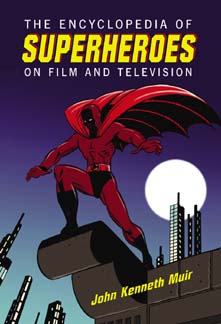|
Spring 2006—John K. Muir (website) is on sabbatical until Summer 2006 for a huge publishing project as his brilliant career begins to soar. His publisher is McFarland, a leading U.S. publisher of scholarly, reference, and academic books (see About John Kenneth Muir below for his bio, web page, and other information). Please be sure to check back. His columns will soon resume at Far Sector SFFH, their home since the turn of the century.###Ed. Note (added June 4, 2006)…and indeed John Kenneth Muir returns with the June 2006 issue. Welcome back, John! Can't wait to read more of your great media reviews. [JTC]
|
March-April-May 2006
Cry_Wolf and Letting Slip the Dogs of War
Media Commentary by John Kenneth Muir
 We all end up with the horror movies we deserve, to misquote somebody famous. Although rarely a fan of PG-13 horror films, I was pleasantly surprised by the quality of a 2005 effort I just screened last night on DVD. It’s called Cry_Wolf and it was directed by newcomer Jeff Wadlow. In a glitzy, streamlined fashion, this unassuming teen horror flick accurately reflects the state of our country right now. It taps into the prevailing Zeitgeist, and how this production reflects some of our current national crises makes for an interesting, if not overly deep, contribution to the genre. We all end up with the horror movies we deserve, to misquote somebody famous. Although rarely a fan of PG-13 horror films, I was pleasantly surprised by the quality of a 2005 effort I just screened last night on DVD. It’s called Cry_Wolf and it was directed by newcomer Jeff Wadlow. In a glitzy, streamlined fashion, this unassuming teen horror flick accurately reflects the state of our country right now. It taps into the prevailing Zeitgeist, and how this production reflects some of our current national crises makes for an interesting, if not overly deep, contribution to the genre.
But more on that in a minute.
First a disclaimer: This film was shot at my alma mater, the University of Richmond. It was a hoot to see a vicious slasher and his victims running amok on the campus where I produced several student films, fell in love with my wife, and attended classes. Although the university’s exteriors were utilized most heavily in Cry_Wolf, some scenes were set inside the English department, in the very office, I believe, where I met with my faculty supervisor! Still, that’s not why I enjoyed the film. It could have been shot anywhere.
Actually, I appreciated the movie because I spend my days lately thinking (and reviewing) a plethora of films just like Cry_Wolf. I’m currently on a tight deadline to turn in Horror Films of the 1980s, a follow-up to my successful 2002 book, Horror Films of the 1970s. I’ve watched three-hundred-and-thirty horror movies from the decade of Reagan on this project, and as some of you will recall, the dominating form in that age was indeed the slasher film paradigm. I’ve watched dozens of slashers in the past months, from the famous ones such as Friday the 13th (1980), Happy Birthday to Me (1981) and My Bloody Valentine (1981) to obscure ones like Final Exam (1981), Graduation Day (1981), Terror at Tenkiller (1986) and--God help me!--Home, Sweet Home (1980).
What I’ve learned from this crash course in the so-called “knife-kill” milieu is that--much like Kabuki Theater or Shakespeare tragedies, the slasher film is a highly ritualized form. These movies feature very little variation in terms of setting, characters and storylines. The fun, and indeed the artistry inherent in this particular brand of cinema arises not from the stories vetted (which truly are interchangeable), but rather in how the common ingredients of the paradigm are juggled, re-arranged, subverted and mirrored to keep audiences off-base.
For instance, there are certain common components that appear in virtually every example of the genre, whether you’re talking about the classics like Halloween (1978), lesser known fare such as He Knows You’re Alone (1980) or more post-modern examples, like Scream (1996) and I Know What You Did Last Summer (1997). Here’s a few of the things what we, as audiences, understand going into a slasher movie in 2006:
- A transgression shall occur. Someone--usually a teenager--will misbehave badly, and the film’s slasher will make him or her (and friends…) pay for that transgression. Rule # 1: Vice always precedes slice-and-dice.
- The slasher in these films always stands out in some egregious fashion from his designated victim pool. Mainly by appearance. This means the killer adorns a mask or costume. And he also boasts an unusual weapon of mass destruction.
- Because the killer dons a mask, his true identity is unknown. To keep it a secret (and to keep audience suspense high…) for as long as is humanly possible, slasher films throw out abundant red herrings, characters who might be the killer, but are really just present to mis-direct audience attention.
- Each killing is a set-piece in and of itself, a three-or-four minute, self-contained video clip of sustained horror and ending in bloody murder.
- The pretty, smart girl dies last. She’s known in scholarly circles as the final girl.
So along comes Jeff Wadlow and Cry_Wolf.
This film tells the cautionary story of a transfer student named Owen (Julian Morris), who attends a prestigious, private preparatory academy (say that three times fast…). Almost immediately on arrival, he falls in love with a gorgeous red-head named Dodger (Lindy Booth). Seems that she enjoys playing a game of “sheep” and “wolf” with her circle of rich, indulged friends (a stable which includes Jared Padalecki, star of the WB’s Supernatural).
What this means is that a “shepherd” and a “wolf” get together, tell a lie, and try to weed out the sheep. After one such successful campaign in a chapel at midnight, Dodger and Owen decide to up the ante a bit. A woman--a “townie”--has been found murdered near campus, and our heroic duo decides to play “wolf” with the whole school, making up a tall tale that a serial killer is targeting students, and that he will kill again. In fact, he kills on the full moon…which is the very next weekend.
Why, these pesky kids even plan their own fake demises! Down. To. The. Last. Detail.
But, of course, something goes terribly wrong. Perhaps the real killer is mad that he’s been outed, because Owen begins to receive threatening instant messages to that effect (our modern day equivalent to the threatening phone calls in classics from When A Stranger Calls [1979] to Prom Night [1980]). Then Owen’s friends begin to die one-at-a-time. Or do they? Is someone really just playing a game, even right up to the bitter end?
What I enjoyed about Cry_Wolf is the manner in which it plays so wickedly and knowingly with the established slasher movie paradigm. Here the transgression is a lie, just as we expect, but what’s fun is that the liars themselves determine the appearance of the killer. For instance, they decide their phantom bogeyman should wear camouflage and an orange ski cap. And…he does.
Red herrings also abound. One old man keeps re-appearing in shots. He’s the school’s custodian, and in the time honored tradition of Prom Night (1980) and Funeral Home (1982), he’s a suspect. So is the journalism teacher, played by John Bon Jovi. Seems as though he’s been a little too friendly with Dodger lately…
Basically, every character in this film (save one…the killer) serves as the red herring at some point or another. Because of the “game” set-up at the beginning of the film, everybody--to quote Scream--“is a suspect.” This approach grants Cry_Wolf an edgy air of uncertainty. We know all the cliches, but we’re--excuse the pun--dying to know how they’re all going to play out.
Finally, the murder scenes in Cry_Wolf are inventive, and--impressively--thrive more on the power of suggestion than actual on-screen violence. It’s what the audience thinks it sees in this film that makes all the difference.
And lastly, the final girl does die last. Or at least she appears to. In this case, not to give anything away, the film shares a trait with Night School (1980) and High Tension (2004). Readers who’ve seen both films will know what I’m talking about. ‘Nuff said.
The 1980s slasher films such as Friday the 13th dramatized a very conservative, almost Victorian morality. The teen characters who misbehaved--who smoked pot or had sex--were murdered first. It appears we’ve moved past that dynamic today. And, getting back to my opening thought, this film clearly reflects our 21st century Zeitgeist.
To wit, there is no real bogeyman. Never was. The evil, indestructible slasher was made up from whole cloth, by our very own specifications. In other words, the enemy is us. Or at least those of us who would manipulate fear and lie to achieve a certain end.
In other words, Cry_Wolf’s central thesis “lie to, and manipulate your friends” and “get back at your enemies,” is exactly what happened when this country went to war in Iraq in 2003. The Administration cherry-picked intelligence and created a national fear--nay, paranoia--of a perceived bogeyman (Saddam Hussein). Why, he was coming over here on the next full moon with mushroom clouds! Hatred for this monster was drummed up by the very people who most clearly had a vested interested in invading Iraq (“This is the man, after all, who tried to kill my Daddy,” as President Bush said), and because of fears and lies, our country walked lockstep into a disaster.
The Administration “cried wolf” to coin a phrase, over Iraq and fictional weapons of mass destruction, and the “sheep” (the mainstream media, the Democrats) played along, didn’t they? Think this interpretation of a horror movie is far fetched? Watch Cry_Wolf for yourself and see. Tellingly, the movie ends with a kid pulling the trigger, firing a gun and murdering someone he has no reason to kill. But somebody else has a reason, and uses him as a patsy…
Finally, the only significant way that Cry_Wolf is really and truly different from the 1980s slasher film paradigm is that this new movie omits the most famous shot of the form: a young woman removing her blouse and revealing her breasts. Thus it is definitively proven we live in much more conservative times than we did even in Reagan’s 1980s. That kind of thing (gratuitous nudity) just wouldn’t pass into today’s PG-13 culture.
|




